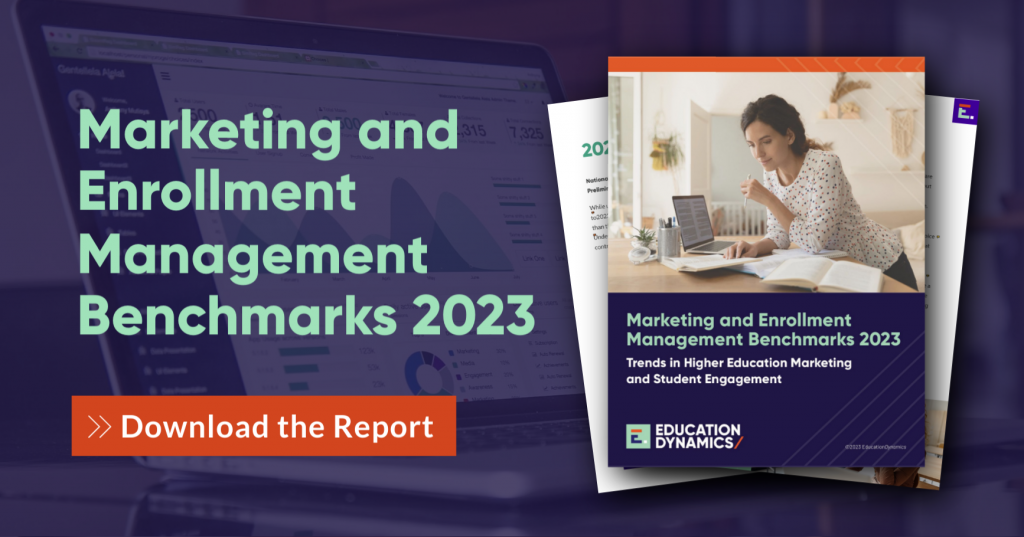Marketing and Enrollment: Benchmarks for 2023

Marketing and Enrollment Management Benchmarks
The landscape of higher education is constantly changing, and it may never reach a state where transformation is complete. We have entered an era of student-centered education that provides greater value for the students we serve. In the modern world, people have more choices than ever before, and there are a lot of headwinds that higher ed institutions face.
Shifts in lifestyles and the inclusion of flexibility and choice have become essential in every interaction that encompasses media consumption, work, education, and beyond. And now, we are faced with a new challenge: how do forward-thinking colleges and universities adapt to this new environment and alter their approach to keep up with all these choices?
We present the findings and recommendations of the 2023 Marketing and Enrollment Management Benchmarks Report to help higher education leaders better focus on and serve today’s modern student. This report looks at student behavior regarding their engagement with various marketing tools. By looking at the trends in higher education marketing and student engagement, we can help you reach these students in ways that are most effective for them.
Student-Led Engagement on Higher Education Websites
The 2023 report revealed findings that prospective college students are engaging with websites more than ever before. Among higher education websites that we monitor, we observed a 40% increase in the time spent on website pages, with an average of 3.1 pages per session. These tech-savvy learners are taking time to truly examine website content to get an accurate picture of the colleges they are considering. With the wealth of online information, they devote more time to researching and exploring each school’s website to determine if it is the right fit for them.
This new breed of students is more informed and engaged than ever before, making it essential for colleges to ensure that their websites provide sufficient information and a clear overview of their programs and facilities. By crafting high-quality website content that is both informative and engaging, colleges can increase the likelihood that prospective students will choose them as their preferred educational destination.
Transformation of the Media Landscape
Another interesting revelation from the report was that streaming adoption is highly prevalent among diverse audiences.
It’s likely that mobile users are not also cable subscribers. So much content is accessed from the palm of your hand, and people do not see the value in paying for channels they don’t watch. Instead, they are turning to their iPads and androids to stream television for entertainment. Their budgets are still intact as they are more willing to watch ad-supported tiers of these streaming services. This legion of viewers has surpassed cable watches as more than one-third of all tv consumption in the U.S. is done through streaming media.
An important finding was that 24% more African American, 17% more American Indian, and 16% more Hispanic households have switched to streaming TV in two years.
Why share this statistic with you?
To show how a diverse audience of viewers is turning to streaming television, groups that are often underserved. This group represents more than 40% of households watching ConnectedTV in the U.S. When you finally have the undivided attention of this audience, what will you say? Thoughtful and authentic messaging are going to be critical here. This is your chance to improve brand awareness by making your ads memorable, including personalized messaging with conversational language to engage those interested students.
Trends in Contact Rates
Another key takeaway from the Marketing and Enrollment Management Benchmarks report are the trends observed when successfully contacting students. These findings offer some insight into how to improve your outreach efforts.
Marketing your higher ed institution via phone calls, SMS messages, and emails is less effective than it used to be, but students are still engaged in those channels. According to the report, contact rates among graduates varied little from 2021 to 2022, staying consistent at 55%, while undergraduate rates decreased slightly by 3%. Despite declining enrollments, students continue to be interested in enrolling to get their credentials, particularly those at a graduate level.
And what’s more, the factors contributing to communication are laid out in the Marketing and Enrollment Management Benchmarks 2023 report. It provides insights into which days of the week are best for communicating with prospective students and provides the opportunity to discuss important items like academic background, program offerings, or career goals.
These insights can help you make better decisions when it comes time to market your higher education programs. Building awareness of your brand and creating personalized messages will help you connect more effectively with students. And maybe it isn’t so much about reaching out as it is making sure that when you do reach out, it’s at the right time.
How Can Institutions Adapt to These Changes?
In order to stay competitive and survive in today’s higher education environment, it’s crucial to provide students with programs that let them study when, where, and how they want. Student success depends on the institution’s ability to support students from awareness through graduation and its willingness to work with career-ready students as they balance work, education, and other competing priorities.
Institutions that thrive in 2023 and beyond will be those that build a strong connection between their brand and the promise of their offerings.
Ready to grow your enrollments? Get the insight you need to reach your goals. Download the Marketing and Enrollment Management Benchmarks 2023 report.
